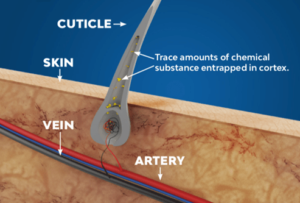Introduction to Hair Follicle Testing
Hair follicle testing is a sophisticated method used to detect the presence of drugs and alcohol in an individual’s system. Unlike other forms of testing, such as urine or blood tests, hair follicle testing offers a longer detection window, providing valuable insights into an individual’s substance use history. This comprehensive guide delves into the use of hair follicle testing in detecting alcohol and drugs, the areas from which hair can be harvested, its detection periods, testing procedures, and its application in legal and familial contexts.
The metabolites of chronic drug use, Illicit and repetitive is incorporated into hair for a period of about 90 days.
The presence of drugs in hair is based on a simple principle. Drugs which are ingested circulate in the bloodstream which nourishes developing hair follicles. As a result, trace amounts of the target drug or drug metabolite are deposited in the hair follicle and become entrapped in the core of the hair shaft as it grows out from the hair follicle.

Normal growth rates for human hair are approximately 3.5 cm per month. By testing for the presence of drugs in the hair shaft core on a given length of hair, a historical record of past drug usage can be constructed. Since target drug or drug metabolite residues are chemically and structurally stable for an extended period of time within the hair shaft core, they cannot be externally washed, bleached, chemically treated or flushed out of the hair structure. Consequently there is little possibility of sample contamination or manipulation. For this reason many courts and legal entities and pre employment and work screening have chosen hair drug test as the preferred method of drug testing.
Laboratory analysis of the hair shaft from an individual can achieve highly accurate drug test results and provide a historical use record. Generally it takes approximately 5 days for drugs to show up in a person’s hair and they will continue to be detectable in the hair for several months.
Hair follicle testing for alcohol is based on testing for EtG. (Read more about EtG here). EtG is absorbed into entire length of the hair via diffusion and sweat.
Drugs and various metabolites including those of alcohol, enter the hair shaft by passive diffusion from the capillaries surrounding the follicle as well as diffusion from the sweat glands and deep skin compartments. Hair can be collected from anywhere on the body but the preferred location is the posterior vertex of the scalp. Ideally about 50 to 100 mg of hair is used either in total as a composite test or segmented into a sequence of lengths for yielding a chronological level of use based on 30 day increments.Hair samples are increasingly used for the detection of chronic drug and alcohol abuse because the results are specific and precisely stated in picograms or nanograms per milligrams of sample. Urine and saliva testing remain useful tools for immediate evaluation, but generally are accurate for a period not exceeding 72 hours of ingestion.
Hair Follicle Testing can Detect the Following Drugs
- Amphetamines Methamphetamine MDMA MDEA
- Phencyclidine
- Cannabis
- Cocaine
- Opiates
- Ecstasy (MDMA)
- Mephedrone Amphetamine Depravities
- Methadone Opiate Depravities
- Alcohol (an additional test If requested)
Areas for Hair Follicle Harvesting
Hair follicle testing involves the collection of hair from various parts of the body. The most common areas for hair follicle harvesting include:
- Scalp: Hair samples are often collected from the scalp due to its accessibility and ease of collection.
- Armpits (Axillary Hair): Axillary hair, located in the armpits, can also be utilized for hair follicle testing.
- Chest and Back: Hair from the chest and back regions can provide additional samples for testing, particularly in cases where scalp hair is unavailable.
Detection Periods of Hair Follicle Testing
Hair follicle testing offers a longer detection window compared to other testing methods, making it a valuable tool in determining an individual’s substance use history. The detection periods for various substances are as follows:
- Drugs: Hair follicle testing can detect a wide range of drugs, including cocaine, marijuana, opioids, amphetamines, and methamphetamine. Depending on the length of the hair sample collected, drug use can be detected for up to 90 days or longer, depending on the growth rate of the hair.
- Alcohol: While less common than drug testing, hair follicle testing can also detect chronic alcohol consumption. Alcohol markers, such as ethyl glucuronide (EtG) and fatty acid ethyl esters (FAEEs), can be detected in hair samples for up to three months or more.
Procedures of Hair Follicle Testing
Specimen Collection
The collector obtains a 50 to100 milligram sample of hair (90 to 120 strands) cut at the scalp and completes chain-of-custody documentation., the process minimizes the likelihood of sample adulteration or specimen substitution.
The process of hair follicle testing involves several key steps:
- Sample Collection: A small sample of hair is collected from the chosen area of the body using scissors or clippers. The sample is typically taken close to the scalp to capture recent drug or alcohol use.
- Sample Preparation: The collected hair sample is then cleaned and prepared for testing to remove external contaminants.
- Testing and Analysis: The prepared hair sample undergoes laboratory testing using specialized equipment to identify the presence of drugs or alcohol metabolites.
- Interpretation of Results: The results of the hair follicle test are interpreted by qualified professionals, taking into account the presence and concentration of substances detected.
A concentration level greater than or equal to 30 pg/mg of EtG in head hair (3 cm up to 6 cm) strongly suggests chronic excessive alcohol consumption.
Things to avoid prior to collection of Hair Sample:
Avoid hair gel or oils for 24 to 48 hours
Avoid dying hair
Avoid coming with Hair bun or Pony Tail
Avoid Braids or Deadlocks
Synthetic Hair or Added hairs are not suitable for collection
Use of Hair Follicle Testing in Legal and Familial Contexts
Hair follicle testing is widely used in legal and familial settings for various purposes:
- Courts and Law Enforcement: Hair follicle testing is employed by courts and law enforcement agencies to assess substance use history, particularly in cases involving probation, custody disputes, or criminal investigations.
- Family Law: In family law proceedings, hair follicle testing may be utilized to determine parental fitness or suitability in child custody cases, adoption evaluations, or substance abuse interventions.
Conclusion
Hair follicle testing represents a valuable and versatile method for detecting drugs and alcohol in individuals, offering a longer detection window compared to other testing methods. By understanding the procedures, detection periods, and applications of hair follicle testing, professionals in legal, medical, and familial settings can utilize this tool effectively to assess substance use history and make informed decisions.
Q: How soon after use can a drug be detected in hair?
Drug (and/or metabolite) can be detected approximately seven to 10 days from the time of drug use. This is the time in which the affected hair grows from the follicle to emerge above the scalp.
Q : What is Involved in Hair Follicle Drug Testing ?
collect Hair sample from the Body for testing purposes
Predominantly from the head about 50to 100 mg. Minimum length of hair has to be greater than 3.5 cms
If the scalp hair is too short or not present, hairs can be collected from different parts of the body (except pubic hair) like chest, Arm pits, leg or arms -May involve dry shaving
Rarely Moustache or beard hair can also be collected if necessary
If no hairs are available nail clippings from the fingers collected as alternative.
How much alcohol does it take to show up in a hair test?
It’s difficult to know exactly how much it takes to produce a positive result because each person metabolizes alcohol differently. But it doesn’t take muchTrusted Source.
Low EtG readings in test results can show whether a person has been drinking recreationally or socially. This could be as few as one or two drinks a week.
The concentration of EtG could also indicate whether a person drinks habitually or may have alcohol use disorder. Even a high concentration from one drinking episode would likely be high enough to produce a positive result.
In summary, hair follicle testing serves as a powerful tool in detecting drugs and alcohol in individuals, offering valuable insights into substance use history over an extended period. Understanding its procedures, detection periods, and applications is essential for professionals in various fields, enabling them to make informed decisions in legal, medical, and familial contexts.


